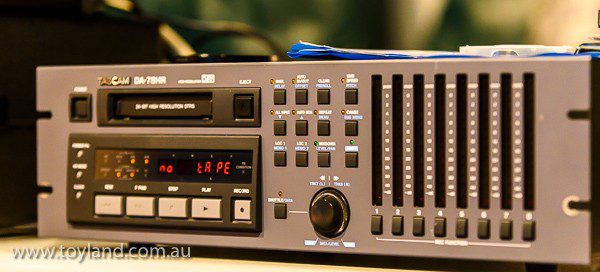Audio Nerd Blog Alert – How To Spend 45 Minutes
A few months ago, I picked up a TASCAM DA-78HR for the outrageous amount of $100(AU); this is a 24bit, 8-track digital tape machine, that I had absolutely no use for. I thought it would make an interesting rack-filler (not that I have any empty rack space – but that’s audio addiction for you, and it was only $100!). The short version of this story is: it all works; the long version for the two-and-a-half people that have read this far, is as follows…
With a little time to spare, I decided to get the DA-78HR working with my current DAW, Nuendo 7. The first thing I needed was a TDIF cable (Tascam digital format). Luckily I still had a few of these from my old Soundscape system that used TDIF for its AD/DA boxes. The hardest part of this whole exercise was locating them in my huge box of miscellaneous “computer cables” featuring the many formats of days gone by.
My current DAW setup is based on the MOTU PCIe 424 card, this has four ports into which you plug your convertors. I have used two ports each with a HD192 12 channel interface, giving me 24 balanced +4 XLRs in and out. As luck would have it, I also have a 2408 MK3 kicking around for a totally different purpose; the 2408 has three banks, each bank can be 8 channels of either ADAT or TDIF (so..another 24 channels of I/O ), and it also has 8 analogue, SPDIF, SMPTE and Word Clock I/O.
I plugged the 2408 into the third port on the 424 card, and then the TDIF cable from one of the three TDIF ports on the 2408 into the DA78HR. At this point I should have 8 channels of bi-directional digital audio between the DAW and tape machine, but instead I was met with many blinking lights and glitching audio. I recognised this straight away as a clocking issue, because I had wrongly assumed the tape machine would lock to the the embedded clock in the TDIF digital signal, but it didn’t. So one more RCA cable was needed, to feed the tape machine Word Clock from the 2408, and after some cryptic menu diving, all was perfect!
So far, so good, but there was more to do! I wanted to slave the tape machine to the DAW. I fed the SMPTE out from the 2408 to the SMPTE in on the DA78HR, but to no avail. The SMPTE out of the 2408 only comes to life with the MOTU included SMPTE console app, great for striping SMPTE, but not much use here as it’s not being sent from the session. Instead, I used Nuendo’s built-in SMPTE plugin, and fed that to one of the 8 analogue outs, then into the DA78HR, and once again with a bit of diving into the SYNC menu and a push of the “chase” button on the front of the DA78HR, it was working! And boy does it work! Syncs like a MF! No matter where I play the DAW the DA78HR winds to that position and plays or records as you have set.
This particular machine was one of the very last tape-based machines of any kind in widespread professional use, before hard-disk-based recording took off. Its SMPTE chasing and locking is about as good as it gets. I can record 8 channels of drums from the DAW session onto the tape and then record them back to DAW, and the timing is so precise, it’s like they never left.
So after all that, I have 8 channels of digital, bi-directional and tightly locked between DAW and tape machine, and… and… so what‽ Will I ever use it like that..? Nope. This is not an analogue tape machine that imparts its own sound character, and I have more tracks and convenience than I could ever use in the DAW on its own, and absolutely no need for this setup. (At least, not unless someone brings a past opus into the studio on DTRS format tape for transfer.)
But it kept me mildly amused for 45 minutes!
